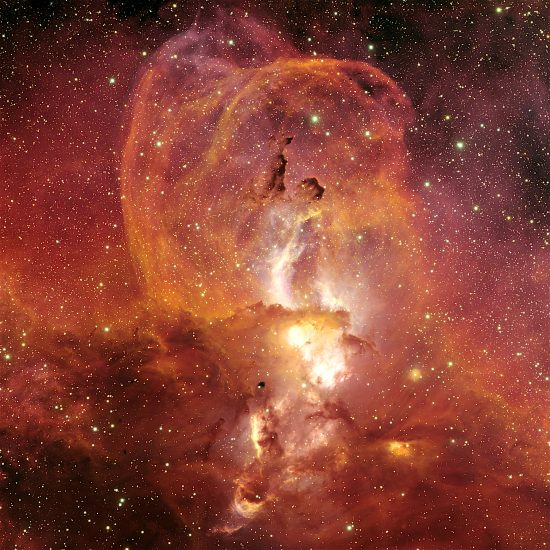
Nebular star-forming region NGC 3582. Credit: T. A. Rector (U. Alaska), T. Abbott, NOAO, AURA, NSF. Click to enlarge.
Aug 24, 2018
Stars are not born out of frigid emptiness.
Gravity is a weak force compared to electromagnetism. When objects fall in Earth’s gravitational field, they accelerate with a sluggish 9 meters-per-second, squared. However, when they encounter the electromagnetic fields of some substance, like a sidewalk, they decelerate instantly; the electric force in the sidewalk’s molecules resist the electric force in the falling object’s molecules so effectively that acceleration is immediately halted.
Moving out into space, it is thought that shock waves generated by supernovae ram through planetary nebulae, forcing the wisps of dust and gas to compress. That is what is said to initiate star formation. How shock waves propagate through a medium composed of about one atom per cubic centimeter, until they encounter a nebular cloud thousands of light-years away is not known, however. Further, shock-heated gases should dissipate when their molecular movement increases, not collapse.
Therefore, most astrophysical models require a gas cloud to be cool and possess no magnetic fields in order for it to collapse under its own weight. Otherwise, as mentioned, it would dissipate. However, in the so-called “stellar nurseries”, new stars are always embedded in chaotic regions of hot dust, energized plasma, and electromagnetic fields. It is only with an Electric Star theory that such dichotomies can be resolved.
Recently, astronomers announced that the Milky Way is now in its “second life”. The article abundantly illustrates attempts to overcome the paradox of cold compression. In a previous epoch, “cold flow accretion” took place as cold gases and dust flowed into the galaxy, providing material for star formation.
Conventional astrophysicists believe that stars are whirling vortices of compressed matter heated to fusion temperatures by pressure, alone. Once a shock wave starts the process, gravity is said to draw together clouds of gas and dust that are far less dense than a puff of smoke. As written, the Interstellar Medium is thought to contain one atom per cubic centimeter, so those clouds are indeed sparse. Irrespective of their ephemeral nature, the clouds coalesce, coaxing even more material to collect, until the proto-stellar matter can no longer resist the inward pull and it explodes in a nuclear fusion reaction.
As stated many times in previous Pictures of the Day, Electric Star theory provides solutions to the puzzles and confusion so often expressed in science journals. A fundamental aspect of the Universe is that it is composed almost entirely of plasma. Those tendrils of gas and dust so dear to astronomers are not electrically neutral, since plasma forms double layers that create a flow of electric charge.
Plasma responds to electrodynamic forces and not only to gravity, so electricity drives the cosmos.
Stephen Smith












